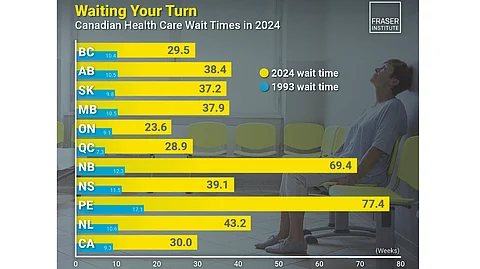

Wait times in Canadian health care keep getting longer according to an annual study by the Fraser Institute which also finds prairie provinces trailing the 30-week long national average.
To document the queues for visits to specialists and for diagnostic and surgical procedures in the country, the Fraser Institute has — for over 30 years — surveyed specialist physicians across 12 specialties and 10 provinces.
The latest edition of Waiting Your Turn indicates that, overall, waiting times for medically necessary treatment have increased since last year. Specialist physicians surveyed report a median waiting time of 30.0 weeks between referral from a general practitioner and receipt of treatment — longer than the wait of 27.7 weeks reported in 2023.
This year’s wait time is the longest wait time recorded in this survey’s history and is 222% longer than in 1993, when it was just 9.3 weeks.
The total wait time that patients face can be examined in two consecutive segments, the first from referral by a general practitioner to consultation with a specialist.
The waiting time in this segment increased from 14.6 weeks in 2023 to 15.0 weeks in 2024. This wait time is 305% longer than in 1993, when it was 3.7 weeks. The shortest waits for specialist consultations are in Quebec (9.1 weeks) while the longest occur in Prince Edward Island (39.8 weeks).
Next, the wait from a consultation with a specialist to the point at which the patient receives treatment increased from 13.1 weeks in 2023 to 15.0 weeks this year.
This wait time is 167% longer than in 1993 when it was 5.6 weeks, and 6.3 weeks longer than what physicians consider to be clinically “reasonable” (8.6 weeks). The shortest specialist-to-treatment waits are found in Ontario (10.9 weeks), while the longest are in Prince Edward Island (37.6 weeks).
The Fraser Institute estimates that the total number of procedures for which people are waiting in 2024 is 1,543,994. Assuming that each person waits for only one procedure, that's 3.7% of Canadians.
The proportion of the population waiting for treatment varies from a low of 3.08% in Ontario to a high of 7.97% in Prince Edward Island. Physicians report that only about 15% of their patients are on a waiting list because they requested a delay or postponement.
Patients also experience significant waiting times for various diagnostic technologies. This year, Canadians could expect to wait 8.1 weeks for a computed tomography (CT) scan, 16.2 weeks for a magnetic resonance imaging (MRI) scan, and 5.2 weeks for an ultrasound.
Data were collected from the week of January 19 and May 31, 2024. A total of 1,973 responses were received across the 12 specialties surveyed—a response rate of 17%.
Research has repeatedly indicated that wait times for medically necessary treatment are not benign inconveniences. Wait times can, and do, have serious consequences such as increased pain, suffering, and mental anguish. In certain instances, they can also result in poorer medical outcomes — transforming potentially reversible illnesses or injuries into chronic, irreversible conditions, or even permanent disabilities. In many instances, patients may also have to forgo wages while they wait for treatment, resulting in an economic cost to themselves and the general economy.
"The results of this year’s survey indicate that despite provincial strategies to reduce wait times and high levels of health expenditure, it is clear that patients in Canada continue to wait too long to receive medically necessary treatment," write Fraser Institute authors Mackenzie Moir and Bacchus Barua.
Orthopaedic surgeries have the longest wait by far, with the wait time from GP to specialist taking 21.9 weeks, followed by another 35.7 week wait from specialist to treatment, leading to a total wait of 57.5 weeks. This is longer than one year.
